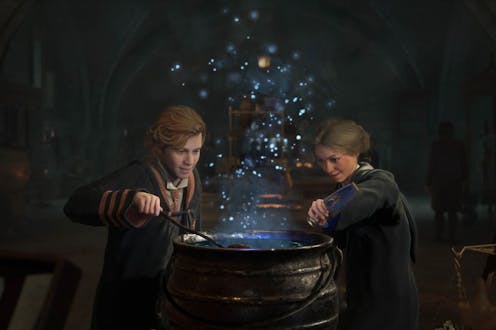Hogwarts Legacy's game mechanics reflect the gender essentialism at the heart of Harry Potter
- Written by Prema Arasu, Postdoctoral research fellow, The University of Western Australia

The controversial and keenly anticipated open-world role-playing game Hogwarts Legacy was released a week ago, and reviews[1] have been mixed. Some have praised the sweeping expanses of Hogwarts castle and its surrounds, and others have criticised its stagnant loot-collection mechanics. Much of the discourse has centred on tensions and expression around gender.
The game has been subject to controversy[2] regarding the anti-trans[3] remarks made by the Wizarding World franchise’s creator, Harry Potter series author JK Rowling.
Many reviews[4] are prefaced by denouncements of Rowling and her views on gender, while some Harry Potter fans argue[5] that the work should be separated from its originator.
Rowling has written[6] about her “deep concerns about the effect the trans rights movement is having”. The inclusion of a trans character and other gender-inclusive elements by the developers, such as character creation mechanics, show that tensions around gender expression also manifest in Hogwarts Legacy.
Gender in Harry Potter
The Wizarding World of Harry Potter, on which Hogwarts Legacy is based, is deeply structured around a patriarchal gender binary. The in-world equivalents for male and female are “wizard” and “witch”, respectively, but the default term for someone who uses magic is wizard – much as the word “man” refers to both the gender and the human species.
Anxieties about men in female spaces appear in Harry Potter and the Order of the Phoenix, in which Ron attempts to enter the girls’ dormitory. The staircase magically transforms into a slide and he is ejected. No such system exists for the boys’ dormitories.
A metaphorical kind of identity-essentialism is built into the Sorting Hat process of Hogwarts as well. At the age of 11, new students of Hogwarts are “sorted” into a school house. Their house determines what colours they wear, whom they share living spaces with, and whom they have their classes with, and it inevitably becomes a huge part of their identity during their time at Hogwarts and into their adult lives. This decision is made by a sentient hat who looks into each peri-pubescent child’s mind and decides their fate forever.
Transitioning house is not an option.
Gender in Hogwarts Legacy
So how does Hogwarts Legacy metabolise all of this? Hogwarts Legacy supposedly features the first transgender character[7]in the Wizarding World franchise, a witch named Sirona Ryan, who is the proprietor of the Three Broomsticks.
The game’s character creation system approaches gender in a way that suggests it is trying to distance itself from Rowling, by ostensibly allowing players to create their own[8] trans player characters.
But I think it is slightly more complex than this.
Hogwarts Legacy is an open world role-playing game (RPG), meaning the player starts the game by creating their own character[9] before the story begins.
Read more: Harry Potter and the legacy of the world's most famous boy wizard[10]
Conventionally, RPG character creation starts with choosing a sex for your character. This determines what their body will look like, and often limits the cosmetic options for hairstyle and clothing. It also usually determines the pitch of your character’s voice during gameplay and the pronouns with which your character is referred to by others during cinematic cutscenes.
More recently, RPGs are incorporating slight changes to their character creation systems[11] to make them more inclusive. In 2022’s Game of the Year, Fromsoft’s Elden Ring, players can choose between “Body A” or “Body B” in place of male or female.
Similarly, in Hogwarts Legacy, players begin by choosing a starting appearance from a selection of presets, half of which are wearing skirt versions of the starting outfit, and half wearing trousers. Players then go on to modify facial features, hairstyle and voice.
Players also name their own characters. Because of how voice-acted cutscenes work in games, the player character is never referred to by their customised name. The player character is always spoken of using they/them pronouns, or called “the child”.
In this, players can chose from a variety of gendered characteristics, and are in many ways non-binary. But when this is done, players are asked to select whether they are a “witch” or “wizard”. An on-screen note indicates that this determines which dormitory they are placed in.
Once the game begins, players may make some cosmetic modifications[12] to their character but cannot change their gender, much as they cannot change their house.
Although Hogwarts Legacy’s developers have incorporated mechanics to make the game more inclusive, the world in which it is set is a product of its creator’s views.
References
- ^ reviews (www.gamesradar.com)
- ^ controversy (www.gamespot.com)
- ^ anti-trans (www.avclub.com)
- ^ reviews (steamdeckhq.com)
- ^ argue (theconversation.com)
- ^ written (www.jkrowling.com)
- ^ first transgender character (edition.cnn.com)
- ^ create their own (www.gamespot.com)
- ^ creating their own character (youtu.be)
- ^ Harry Potter and the legacy of the world's most famous boy wizard (theconversation.com)
- ^ character creation systems (gamerant.com)
- ^ some cosmetic modifications (www.gamerevolution.com)

















